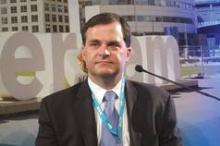AMSTERDAM – Immunotherapy with ipilimumab provides a durable, long-term survival benefit in patients with metastatic or locally advanced melanoma, a pooled analysis confirms.
Median overall survival was 11.4 months and 3-year survival 22% among 1,861 patients receiving ipilimumab (Yervoy) in a mixture of 12 clinical trials.
When data from 2,985 additional patients in the expanded access program were included, median overall survival was 9.5 months and 3-year survival 21%, Dr. F. Stephen Hodi Jr., director of the Melanoma Center at the Dana-Farber Cancer Institute, Boston, said at the European Cancer Congress 2013.
The pooled analysis, involving eight prospective phase II, two prospective phase III, and two retrospective, observational trials, is the largest survival analysis of ipilimumab to date and provides the most precise estimate yet of its survival benefit.
The analysis (LBA24) also confirms the observation that the survival benefit of ipilimumab plateaus around 3 years and that patients who are alive at this point maintain a long-term survival benefit, Dr. Hodi said. No deaths have been reported after 7 years, with some patients surviving for up to 10 years.
"A few years ago, we would never imagine using the ‘C’ word, cure, and to see some patients living long term," he said at a press briefing. "Our goal as clinical investigators is to find something that cures patients of their disease, but at least what we’re showing here is that we’re having a great paradigm shift of maybe curing a subset of patients; it’s hard to use that term, but at least turning their disease into a chronic illness, which is a huge paradigm shift from where we were just a few years ago."
The survival benefit was not affected by prior therapy, ipilimumab dose (3 mg vs. 10 mg), or inclusion of the expanded access program (EAP) data, Dr. Hodi said.
Prof. Martin Gore, medical director of the Royal Marsden Hospital and professor of cancer medicine at the Institute of Cancer Research, both in London, who was invited to discuss the study, disagreed with this conclusion. He highlighted a 6% difference in 3-year overall survival between treatment-naïve and previously treated patients (20% vs. 26%) and a 3% difference in 3-year overall survival between those receiving the licensed 3-mg/kg and 10-mg/kg doses (21% vs. 24%). While these differences probably don’t make a difference in the clinic, they could be relevant with large numbers of patients in clinical trials, he said.
The EAP data would have been better utilized as a validation set to evaluate "real world" toxicity with ipilimumab, rather than being included in the pooled analysis, he said.
Prefacing further remarks with the comment, "I have not treated a patient with IL-2 [interleukin-2] for 15 years, so I’m not an apologist for it," Prof. Gore also pointed out that the 9.5-month median survival in the pooled analysis is "within the bounds" of what IL-2 provided 20 years ago when it posted a median survival of 10.5 months and 3-year survival of 15% in 631 patients with stage IV melanoma (J. Clin. Oncol. 1998;16:2921-9).
Still, Prof. Gore said clinicians should advise their patients that ipilimumab produces a 10% improvement in survival over conventional therapy and to say "that if you reach 3 years, you may well be home and dry ...
"I think there’s a potential cure for some patients, I think we can say that," he added. "But it’s not a competition with targeted agents. That’s really, really important. This is an adjunctive treatment in the same way as targeted agents are an adjunctive treatment for those with BRAF mutations. We have to learn to put these together."
The big question going forward is who may be unsuitable for ipilimumab and whether the "old rules for immunotherapy" apply, such as poor performance status, high disease volume, and rapidly progressive disease, Prof. Gore concluded.
It’s currently not possible to predict which patients will respond to ipilimumab, but this issue is an area of very active investigation, along with how to combine or sequence immunotherapy and targeted agents, Dr. Hodi said.
Prof. Alexander Eggermont, past president of the European Cancer Organization and director of the Institut Gustave Roussy Comprehensive Cancer Center in Villejuif, France, said in a statement that the pooled analysis demonstrates that with a response rate of only 10%-15%, one can achieve survival of more than 3-10 years in 17%-25% of patients who have received only a few doses of ipilimumab.
"These survival results could even double or triple with anti-PD1/PDL1 [programmed death 1 protein and its ligand] monoclonal antibodies; and metastatic melanoma could become a curable disease for perhaps more than 50% of patients over the coming 5 to 10 years," he commented.

